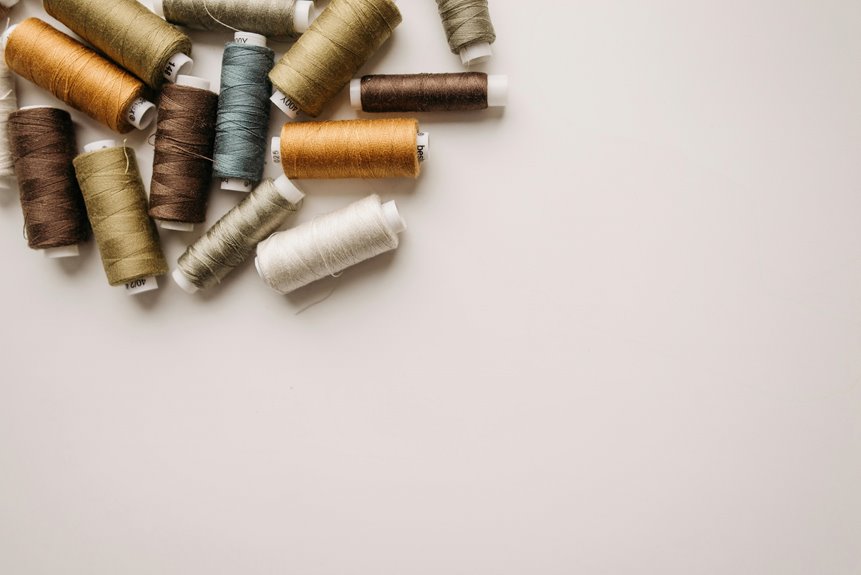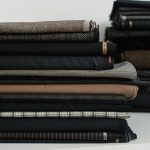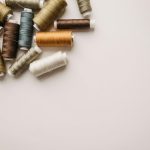You’re looking at jute fabric—a natural, durable fiber often called the “Golden Fibre” for its sheen and eco-benefits. It’s grown mainly in warm, humid areas and harvested after a few months through retting to extract strong fibers. Jute’s breathable, biodegradable, and great for bags, decor, and sustainable products. It absorbs moisture but needs proper care to avoid mildew. Curious about its rich history, production, and uses? Keep exploring to uncover how jute connects tradition with a greener future.
Table of Contents
Key Takeaways
- Jute fabric, known as the “Golden Fibre,” is a durable, coarse natural fiber from the jute plant native to the Indian subcontinent.
- It is produced through retting, harvesting stalks after 4-6 months, soaking them to extract fibers used in textiles and packaging.
- Jute is biodegradable, breathable, moisture-absorbent, and strong, making it ideal for eco-friendly products like bags, rugs, and upholstery.
- Environmentally, jute grows rapidly with low inputs, improves soil health, absorbs CO2, and requires less water and energy than cotton.
- Proper care includes keeping jute dry, airing regularly, avoiding direct sunlight, and gentle cleaning to maintain its durability and appearance.
The History and Origin of Jute Fabric
Jute fabric has a rich history that dates back thousands of years, with its origins rooted in the Indian subcontinent. You’ll find that ancient civilizations valued jute for its durability and versatility, using it to make ropes, mats, and sacks.
As trade expanded, jute’s popularity spread, especially during the British colonial period when it became a major export crop. You can trace its significance to Bengal, where fertile soil and climate created ideal growing conditions.
Over time, jute became known as the “Golden Fibre” because of its natural shine and economic importance. Understanding jute’s origin helps you appreciate its cultural and practical value, showing how it evolved from simple handcrafts to a global commodity that supports millions of livelihoods today.
How Jute Fabric Is Produced
You start by growing the jute plant in warm, humid conditions where it thrives best.
Once mature, the fibers are carefully extracted through a process called retting, which separates them from the stalks.
Understanding these steps helps you appreciate how raw jute transforms into the fabric you use.
Jute Plant Cultivation
Although it takes several months to grow, cultivating this versatile plant is surprisingly straightforward. You’ll begin by selecting a warm, humid climate with plenty of rainfall, as jute thrives in such conditions.
Next, choose fertile, well-drained soil to guarantee healthy growth. You’ll sow the seeds during the monsoon season for peak moisture. Throughout the growth period, you’ll need to maintain consistent watering and control weeds to prevent competition.
Harvesting occurs about four to six months after planting, once the plants turn golden-yellow.
Here’s what you’ll focus on when cultivating jute:
- Warm, humid climate with 1200-2000 mm annual rainfall
- Fertile, loamy soil with good drainage
- Seed sowing during monsoon season
- Regular watering and weeding
- Harvesting when plants mature and change color
Fiber Extraction Process
Once the plants have matured and are ready for harvest, extracting the fibers becomes your next crucial step.
You begin by cutting the jute stalks close to the ground and bundling them. The key process is retting, where you soak these bundles in water for about two weeks. This softens the stalks and loosens the fibers.
After retting, you remove the stalks and strip off the fibers by hand or with simple tools. Next, you wash and dry the fibers thoroughly to prevent mildew.
Finally, you sort and grade the fibers based on their quality and length. This extraction process guarantees you get strong, long fibers fundamental for producing durable jute fabric, ready for spinning into yarn and weaving into textiles.
Characteristics and Properties of Jute
You’ll find jute stands out because of its natural fiber strength and excellent moisture absorption.
It’s also a top choice if you care about environmental sustainability.
Let’s explore what makes jute fabric so unique and eco-friendly.
Natural Fiber Strength
Jute boasts impressive natural fiber strength that makes it ideal for various uses, from packaging to textiles. When you choose jute, you’re getting a fiber that holds up well under stress, thanks to its long, strong strands. This strength helps jute resist wear and tear, making it perfect for bags, rugs, and even upholstery.
Plus, its durability means products last longer without losing quality.
Here’s what contributes to jute’s natural fiber strength:
- High tensile strength comparable to other natural fibers
- Long fiber length providing better binding
- Rough texture enhancing grip in weaving
- Resistance to elongation under pressure
- Strong lignin content adding rigidity
This robust fiber guarantees your jute items stay reliable and sturdy over time.
Moisture Absorption Traits
Moisture absorption plays a key role in how jute performs across different environments.
When you handle jute fabric, you’ll notice it readily absorbs water, thanks to its natural cellulose content. This trait makes it breathable and comfortable in humid conditions but also means it can retain moisture, which might lead to mildew if not dried properly.
You’ll find jute absorbs about 12-13% of its weight in water, which is moderate compared to other natural fibers. Because of this, you should store jute in dry, well-ventilated areas to prevent deterioration.
Keep in mind, its ability to absorb moisture also affects dyeing, as it takes up color evenly. Understanding these moisture traits helps you maintain jute’s durability and appearance over time.
Environmental Sustainability Benefits
Although natural fibers are often praised for their eco-friendliness, few match the sustainability benefits you’ll find with jute. When you choose jute fabric, you’re opting for a material that grows quickly and requires minimal pesticides or fertilizers.
It’s biodegradable, so it won’t linger in landfills like synthetic fibers. Plus, jute cultivation improves soil health and reduces carbon dioxide in the atmosphere. You’ll also appreciate that processing jute uses less water and energy compared to cotton.
Here’s why jute stands out environmentally:
- Fast-growing crop with low agricultural inputs
- Fully biodegradable and compostable
- Enhances soil fertility and prevents erosion
- Absorbs significant amounts of CO2 during growth
- Requires less water and energy in processing
Environmental Benefits of Using Jute
Because it grows quickly and requires minimal pesticides, you’ll find that using jute fabric greatly reduces environmental impact compared to synthetic alternatives.
Jute’s rapid growth and low pesticide needs make it an eco-friendly fabric choice.
When you choose jute, you’re supporting a crop that absorbs large amounts of CO2, helping combat climate change. Jute plants also improve soil health by adding nutrients and preventing erosion, so the land stays fertile for future crops.
Unlike plastic-based fabrics, jute is fully biodegradable, meaning it breaks down naturally without polluting waterways or harming wildlife.
Plus, the production process consumes less water and energy, so your environmental footprint shrinks further.
Common Uses and Applications of Jute Fabric
Jute fabric offers versatility that fits a wide range of everyday needs. When you choose jute, you tap into a natural, durable material perfect for various applications.
You’ll find jute commonly used in:
- Eco-friendly shopping bags
- Upholstery and home décor items
- Rug and carpet backing
- Agricultural sacks for storing grains and produce
- Craft and DIY projects
Its coarse texture and strength make it ideal for these purposes, giving you a sustainable option without sacrificing durability.
Plus, jute’s breathability helps in agricultural uses by preventing moisture buildup. Whether you’re decorating your home or looking for an earth-friendly alternative to plastic bags, jute fabric adapts easily to your lifestyle, making it a smart, green choice for many daily tasks.
Caring for and Maintaining Jute Products
When you bring jute products into your home, keeping them in good shape guarantees they last longer and maintain their natural charm. Avoid excessive moisture since jute absorbs water easily, leading to mildew. Clean spills promptly with a dry cloth and air items regularly to prevent odors. Store jute in a cool, dry place away from direct sunlight to avoid fading. For stubborn dirt, use a soft brush gently.
| Care Tip | Reason |
|---|---|
| Keep dry | Prevents mildew and rot |
| Clean spills fast | Stops stains from setting |
| Air regularly | Avoids musty smells |
| Avoid sunlight | Prevents color fading |
| Gentle cleaning | Maintains fiber strength |
Following these simple steps helps your jute products stay beautiful and functional for years.
Comparing Jute With Other Natural Fibres
Although natural fibers share many eco-friendly qualities, you’ll find distinct differences in texture, durability, and uses when comparing jute with others like cotton, hemp, or flax.
Jute stands out with its coarse texture and excellent strength, making it ideal for bags and rugs. Cotton feels softer and suits clothing, while hemp offers greater durability for heavy-duty textiles. Flax, used for linen, provides a smooth finish and breathability.
Knowing these differences helps you pick the right fiber for your needs.
- Jute: coarse, strong, biodegradable, great for sacks and mats
- Cotton: soft, absorbent, ideal for apparel and bedding
- Hemp: tough, resistant, perfect for industrial and fashion uses
- Flax: smooth, breathable, used in linen fabrics
All are sustainable but vary in water and pesticide needs.
Frequently Asked Questions
Can Jute Fabric Be Dyed in Vibrant Colors?
Can you dye jute fabric in vibrant colors? Yes, you can. You can soak it, you can apply dyes, and you can fix colors, but remember, jute’s coarse texture absorbs hues differently than smooth fabrics.
Is Jute Fabric Suitable for Clothing?
You can wear jute fabric, but it’s rough and coarse, so it’s not the best for comfort. It’s better suited for accessories or outerwear rather than soft, everyday clothing you’d want against your skin.
How Does Jute Fabric Perform in Waterproofing?
When it comes to waterproofing, jute fabric won’t float your boat; it naturally absorbs water. You’ll need to treat it with coatings or blends to make it water-resistant, or it’ll soak through like a sponge.
Are There Any Allergies Associated With Jute Fabric?
You might experience mild skin irritation or allergies from jute fabric due to its coarse fibers and natural dust. It’s not common, but if you have sensitive skin, it’s best to test before prolonged use.
Can Jute Fabric Be Blended With Synthetic Fibers?
Yes, you can blend jute fabric with synthetic fibers to enhance durability and flexibility. This combination improves texture and strength, making it suitable for various uses like upholstery, bags, and carpets while maintaining eco-friendliness.
- The Use of Nonwovens in Construction and Civil Engineering - July 11, 2025
- The Use of Nonwovens in Construction and Civil Engineering - July 11, 2025
- The Use of Nonwovens in Construction and Civil Engineering - July 11, 2025







